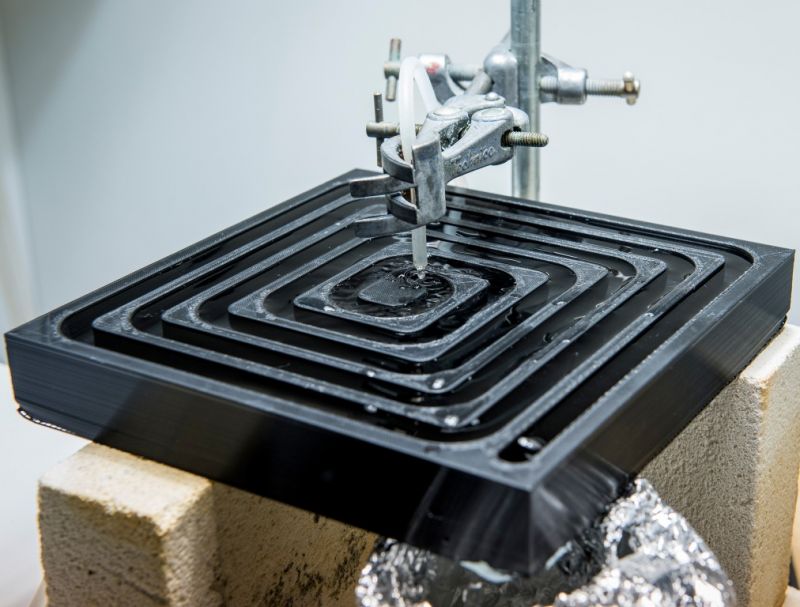3D Printed Maze Developed as Filter for Drinking Water
Published on by Water Network Research, Official research team of The Water Network in Technology
A multidisciplinary team at the University of Bath, UK, is developing a new portable, cheap and efficient device to treat contaminated drinking water for poor communities in the developing world.

Water running through the spiral channels of the University of Bath’s 3D printed flirtation device. Photo by Rob Breckon
The device, designed for household use, is the brainchild of Bath chemical engineer Emma Emanuelsson. She was inspired by the SODIS (SOlar DISinfection) bottle, a PET bottle which uses the heat and UV from sunlight to kill microbes in the water. While cheap and simple, the efficacy of SODIS bottles is dependent on the conditions, and is only a short-term solution as the bottles are not very durable. Emanuelsson set out to develop a more durable solution based on disinfection through heat and UV, in something that began as a “hobby project” with a couple of undergraduates.
“My key motivating factor as an academic has always been just being able to make an impact on people’s everyday life,” said Emanuelsson, adding: “All of a sudden, the UK Research Council launched the Global Challenges Research Fund, taking some of the aid budget and directing it into research that will benefit third world countries. All of a sudden, my pet hobby project, which I thought would never be funded, suddenly became fundable!”
The main part of the device is a slab, created from black plastic, with channels running across the surface. The water runs into the channels and the black plastic heats up in the sun, heating the water to temperatures that kill the bacteria, while it is also exposed to the sun’s UV rays. Making this slab as effective as possible has involved the expertise of many.
Firstly, mathematical modelling determines the time it takes for water to pass through the devices, before digital designers in the civil engineering department develop the most suitable designs. 3D printing is then used to produce prototypes.
“The 3D printing allows us to rapidly produce different prototypes so we can see which one works best. Every prototype will have an issue with it. That’s the benefit of 3D printing, to rapidly generate something, test it, see what we get, use these results and then print another one,” said Emanuelsson.
The next prototype will be twice the size (40 cm x 40 cm) of previous ones, with slightly deeper channels, more curved corners and some small devices to create a bit of turbulence and mixing in the flow. It is a fine balance, however, to ensure that sunlight can still penetrate all the way through the water. The first big prototype will be ready later in the month, which will give the researchers a better idea of how much water each device will be able to treat, although they expect this to be around 35 l/d.
The final device will not be 3D printed, as this is not practical for mass production. Emanuelsson is working with materials science expert Paul Shepherd in the civil engineering department to identify the best materials for the job, which will be stable and durable for long periods of time, and techniques for mass production.
It is hoped that the device will cost just £5 (US$6.4) per unit and weigh around 3 kg. Ideally, Emanuelsson would like to see the device made locally by trained workers. Charles has found in her research that if the local community is involved in the production of a product like this, it is more readily accepted. She is now putting in grant applications to test different ways to implement the technology and get it to market.
Read more: The Chemical Engineer
Media
Taxonomy
- Drinking Water Security
- Treatment
- Drinking Water Treatment
- Filtration
- Technology
- Filtration Solutions
- Filtration
- Access
- Drinking Water
- water treatment
- Printers
- 3D Modelling
- Water Sanitation & Hygiene (WASH)